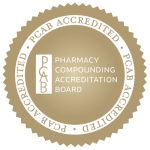Skin conditions are a common occurrence in the veterinary practice for small animals. Depending on the type of skin condition and its severity, many of these skin conditions can be managed by a general veterinary practice. Some of them will need to be seen and treated by a veterinary dermatologist.
This article discusses some of the more common skin diseases seen in canine patients and the compounded treatment options that are currently available.
Common Canine Skin Conditions and Treatments
Canine Atopic Dermatitis is one of the most common causes of chronic itching in dogs. It is an exaggerated allergic reaction to one or more environmental elements usually attributed to a weak immune system. As the etiology is multi-factorial and some breeds may be predisposed to develop this skin condition, the treatment is very complex, entailing a multi-directional approach that must be individualized to meet each patient’s unique needs. Treatments often require the following:
- Desensitizing to environmental allergens
- Long-term treatment consisting of oral corticosteroids, antihistamines, and topical therapy options
- Acute flare-up treatments consisting of oral corticosteroids, short-acting injectable corticosteroids, and topical therapy options
With safety and efficacy considerations at the forefront of care, compounded and individualized treatment options may be prescribed at any point throughout the process.
Prednisone, Prednisolone, and Dexamethasone are just a few examples of corticosteroids that can be prepared in various oral and topical dosage forms. Diphenhydramine and Hydroxyzine are antihistamines that can be prepared in various dosage forms, oral or topical, and can be combined, as needed, with corticosteroids and other drugs based on each canine patient’s unique needs.
Acral lick dermatitis or lick granuloma is another common canine skin condition that benefits from compound medication treatment. Occasionally, a client will bring the dog to a vet office for a spot wound that is potentially infected and located on one of the extremities. Once the behavioral and biological factors that led to the formation of the granuloma have been determined, a personalized treatment plan should be implemented. The treatment plan usually includes customized medication for the granuloma based on its severity and complications and will also address the underlying biological or behavioral issues. A compounded preparation for this condition may look like the following:
- Diphenhydramine HCl 2% Polyox Bandage. Many other ingredients can also be added as needed, including misoprostol, phenytoin, aloe vera, bupivacaine, antibiotics, and antifungals.
- Misoprostol is a prostaglandin analog that, when used topically together with phenytoin, aids in wound healing process.
- Phenytoin is an anti-seizure medication that, when used topically and together with misoprostol aids in the wound healing process.
- Aloe Vera extracted from the plant with the same name can be used topically with beneficial effects in healing affected skin areas.
One can easily understand from this example how veterinary compounding can help customize the medication to the exact need of the canine patient.
Treating Bacterial skin infections
First-occurrence superficial pyoderma/folliculitis can be treated empirically or after bacterial culture and sensitivity. Some of the recommended antibiotics for empirical use are:
- Amoxicillin-Clavulanate can be compounded as an oral oil suspension and infused with flavor.
- Cefadroxil can also be prepared as a compounded oral oil suspension. The exact recommended strength can be incorporated into the food with the patient’s preferred flavor.
- Trimethoprim is an antibiotic used primarily to treat bladder or urinary tract infections that can also be used for some skin infections. One of the dosage forms for this compounded medication may be a flavored, yummy, soft chew treat that will make medication time a treat time for the canine patient.
In more advanced, re-occurring pyoderma cases, where multiple resistance towards antibiotics is already developed (a.k.a. MRSP), the treatment must be done with a carefully selected antibiotic based on the culture results.
Treating Fungal Skin Infection
Malassezia Dermatitis is a common skin condition in dogs caused by a fungus. Malassezia is a commensal fungus found in the dog’s skin, on many parts of the body. When the skin is compromised in some way in dogs with allergies or seborrhea, this yeast may become overgrown, leading to dermatitis and/or otitis. Additionally, some specific dog breeds are more susceptible to Malassezia dermatitis. Typical clinical signs include pruritus, erythema, scaling, waxy exudation, and lichenification.
Treatment for Malassezia dermatitis and/or otitis in dogs must be individualized, based on the patient’s severity of clinical signs, any accompanying diseases, owner compliance, and other varying factors. In most cases, therapy will be both topical and systemic.
Topical therapy is usually effective if patient and owner compliance is high. Topical therapy may be utilized focally in otic canals, facial and tail folds, and interdigital spaces with topical creams, lotions, ointments, and wipes. Generalized dermatitis may be treated with total body applications of shampoos and/or rinses.
One effective option used for this condition as sole therapy is a compounded preparation of a 2% miconazole-2% chlorhexidine shampoo. A keratolytic, degreasing shampoo applied prior to the medicated shampoo can assist in removing excess oils and scale on the patient, resulting in increased efficacy of the medicated shampoo. Otic compounded preparations for Malassezia otitis externa, consisting of either miconazole, clotrimazole, ketoconazole, or thiabendazole, can also help lead to a resolution.
Ringworm is another skin condition commonly occurring in canine patients that is caused by a fungus and can be contagious. It is more difficult to diagnose ringworm in dogs compared to ringworm in cats. Once accurately diagnosed, the treatment will aim to reduce the environmental factors that led to the infection and, of course, to treat the actual fungal infection, itself. Depending on the severity of the infection and other risk factors, the optimal treatment may be systemic/oral, topical, or both. Compounded medicated shampoo or ointment containing miconazole can be prescribed as topical therapy. Griseofulvin can also be prescribed as compounded in various dosage forms including oral suspensions, chewy treats, capsules, and others.
Systemic Therapy Options
If topical therapy is ineffective or not practical for the canine patient, systemic therapy may be utilized. A few options include:
- Azole derivative antifungals
- Ketoconazole is the most frequently used therapy.
- Triazole may be suitable when the patient has contraindications to receiving ketoconazole or failed therapy,
Another option includes the allylamine antifungal, terbinafine. Any of the options mentioned, both for topical and systemic therapy, will provide best results when treatment is customized to the canine patient’s unique needs. All of these outcomes are offered through compounding.
Find Your Canine Compounding Partner
These are only a few of the many examples of how compounded medications can provide valuable, customized options in treating some of the most common canine skin conditions.
For expert advice in hard-to-treat cases in your veterinary practice, please contact one of HALDEY’s experienced pharmacists directly using our dedicated phone line.




